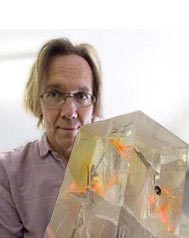About LANL
About Our Capabilities, Facilities, and Staff
"Los Alamos National Laboratory plays an indispensable role in building America as a science and technology powerhouse, and our staff are an incredible resource to the nation and the world." Michael Anastasio, Dir.
Solving Complex R&D Problems with Special Blend of Staff, Capabilities and Facilities
Now in its seventh decade, LANL remains among a very few laboratories that can bring great breadth of fundamental and discovery science, technology, and engineering rapidly together to create tangible solutions for national security needs.
Our staff, working with partners throughout science and industry, must be able to deliver today's solutions while maintaining the depth of capabilities to deliver the next generation of discoveries.
Los Alamos has demonstrated a cycle of innovation where we have developed world-leading capabilities and facilities in response to urgent, unique missions. We also spin out new discoveries that lead to emerging missions.
Being able to integrate and apply our capabilities rapidly to new challenges will be a key advantage in an increasingly competitive landscape.
Our Science, Technology and Engineering Priorities
Science that Matters
- Information science and technology enabling integrative and predictive science
- Experimental science focused on materials for the future
- Fundamental forensic science for nuclear, biological, and chemical threats
How We Work
- Collaborate, partner and team to make decisive contributions to our sponsors
- Outstanding operational excellence for safety, security, and efficient pursuit of ST&E for our missions
Transform Our Scientific Campus
- Campus for 2020 (consistent with complex transformation)
- Modern science facilities: LANSCE refurbishment, CMR replacement, Science Complex
- Signature facilities for experimental science (MaRIE) and computational science (Roadrunner)
More About This Science
Simplistic Information Molecule Captures Essential Features of Protocell Information System
Creating Life, Saving Lives
Miniature machines repair technology and heal our bodies from within

Quick read
Protocells could completely change technology as we know it. Infinite possibilities, from saving the environment to saving lives.
A computer chip that heals itself, microbe-sized machines that removes greenhouse gases from our skies, nanoscale devices that extract radioactive materials from the environment, or, even more fabulous, a miniscule molecule that heals our bodies from within. Science fiction fantasies? Maybe not. Researchers at Los Alamos are creating life from nonliving materials and life-saving technology is on the horizon.
The ability to self-replicate, metabolize, and evolve into new forms is considered the defining characteristic of living cells, but Los Alamos is creating tiny machines that possess these abilities. Government and science institutes worldwide predict that convergent, or living, technologies will impact our technology and economy within the next 25 years and become key to our technological leadership and national security.
Now, collaborating teams of scientists from Los Alamos National Laboratory (LANL) and across Europe are close to developing the "protocell," a system of molecules that exhibit living cell-like behavior. The microscopic protocell would be the first step toward making lifelike devices that perform specific, useful functions.
"Our goal is not to modify existing living cells and turn them into little machines," says Steen Rasmussen, leader of the Los Alamos Protocell Assembly project. "Our goal is to take those features that make living cells so successful and apply them to something new. Because we're starting from scratch, we can design our protocell to do things that living cells cannot. In theory, we can make it so different that it can operate in any environment-toxic, radioactive, or otherwise. Protocells can also be designed so they don't interact directly with the biosphere."
The Protocell Different
The simple protocell has just three components that interact strongly with each other: a metabolism, an information system, and a container.
The Los Alamos team has already built a pared-down version of a protocell; it has achieved the team's major milestone: it used its information system to control a metabolic pathway that converted external resources into container material. This machine built its own container!
"In a living cell, the DNA creates proteins that control the metabolism's chemical reactions," says Los Alamos physicist and team member Hans Ziock. "In our protocell, the information molecule participates directly in the metabolic pathway, so no protein synthesis is necessary. It's a great simplification."
"Our simplistic information molecule nonetheless captures the essential features of an information system. It makes the reaction work and, in that sense, controls or instructs the metabolism. Though it's a modified DNA base, it can still pair with another base and, in principle, copy itself the way DNA does," Ziock adds. "Lastly, it can join with other bases and become more complex. That might allow for more-efficient metabolic pathways, thereby opening up a way for the protocell to evolve."
Unlike a living cell, the Los Alamos protocell conducts all of its business within the oily part of the bi-layer or at its surface, allowing the protocell to exchange nutrients and wastes with the environment and eliminating the complex cellular resource transportation process. Although this simplified protocell has the features of a complete system, the team still must demonstrate experimentally that the protocell's information molecule can replicate-the critical missing link for completing the first human-made, fully functional protocell.
Multiscale Modeling
To help understand and build a more complex system, the team developed a computational version of all key protocell processes, combining different simulation methods to provide various details. Because of the complexity of the system, it has been surprisingly difficult to simulate the protocell's full life cycle-but Los Alamos researchers are close.
The Laboratory's researchers' greater understanding of how to make self-replicating materials is the big first step toward creating living technology that will benefit society in fundamental ways.

Seismic sounds
Eureka moment arrives with a loud, sharp crack
Paul Johnson finds himself caught up in a mystery—how sound waves from an earthquake can trigger new events at distances far beyond what seemed possible . . .
Currents, the Laboratory's monthly employee magazine, highlighting people in the workplace.







